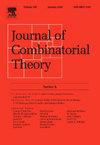An imperceptible connection between the Clebsch–Gordan coefficients of Uq(sl2) and the Terwilliger algebras of Grassmann graphs
IF 1.2
2区 数学
Q2 MATHEMATICS
引用次数: 0
Abstract
The Clebsch–Gordan coefficients of are expressible in terms of Hahn polynomials. The phenomenon can be explained by an algebra homomorphism ♮ from the universal Hahn algebra into . Let Ω denote a finite set of size D and denote the power set of Ω. It is generally known that supports a -module. Let k denote an integer with and fix a k-element subset of Ω. By identifying with this induces a -module structure on denoted by . Pulling back via ♮ the -module forms an -module. When the -module enfolds the Terwilliger algebra of the Johnson graph with respect to . This result connects these two seemingly irrelevant topics: The Clebsch–Gordan coefficients of and the Terwilliger algebras of Johnson graphs. Unfortunately some steps break down in the q-analog case. By making detours, the imperceptible connection between the Clebsch–Gordan coefficients of and the Terwilliger algebras of Grassmann graphs is successfully disclosed in this paper.
Uq(sl2)的Clebsch-Gordan系数与Grassmann图的Terwilliger代数之间难以察觉的联系
U(sl2)的Clebsch-Gordan系数可以用Hahn多项式表示。这一现象可以用从通用哈恩代数H到U(sl2)⊗U(sl2)的代数同态解释。设Ω表示大小为D的有限集,2Ω表示Ω的幂集。众所周知,C2Ω支持U(sl2)-模块。设k为0≤k≤D的整数,固定Ω的一个k元素子集x0。通过将C2Ω与C2Ω∈x0⊗C2x0识别,在C2Ω上得到一个U(sl2)⊗U(sl2)模块结构,表示为C2Ω(x0)。通过缩回调,U(sl2)⊗U(sl2)-模C2Ω(x0)形成h模。当1≤k≤D−1时,h模C2Ω(x0)包涵Johnson图J(D,k)关于x0的Terwilliger代数。这个结果将两个看似无关的主题联系起来:U(sl2)的Clebsch-Gordan系数和Johnson图的Terwilliger代数。不幸的是,在q模拟的情况下,有些步骤失效了。本文通过绕弯路,成功地揭示了Uq(sl2)的Clebsch-Gordan系数与Grassmann图的Terwilliger代数之间不易察觉的联系。
本文章由计算机程序翻译,如有差异,请以英文原文为准。
求助全文
约1分钟内获得全文
求助全文
来源期刊
CiteScore
2.90
自引率
9.10%
发文量
94
审稿时长
12 months
期刊介绍:
The Journal of Combinatorial Theory publishes original mathematical research concerned with theoretical and physical aspects of the study of finite and discrete structures in all branches of science. Series A is concerned primarily with structures, designs, and applications of combinatorics and is a valuable tool for mathematicians and computer scientists.

 求助内容:
求助内容: 应助结果提醒方式:
应助结果提醒方式:


